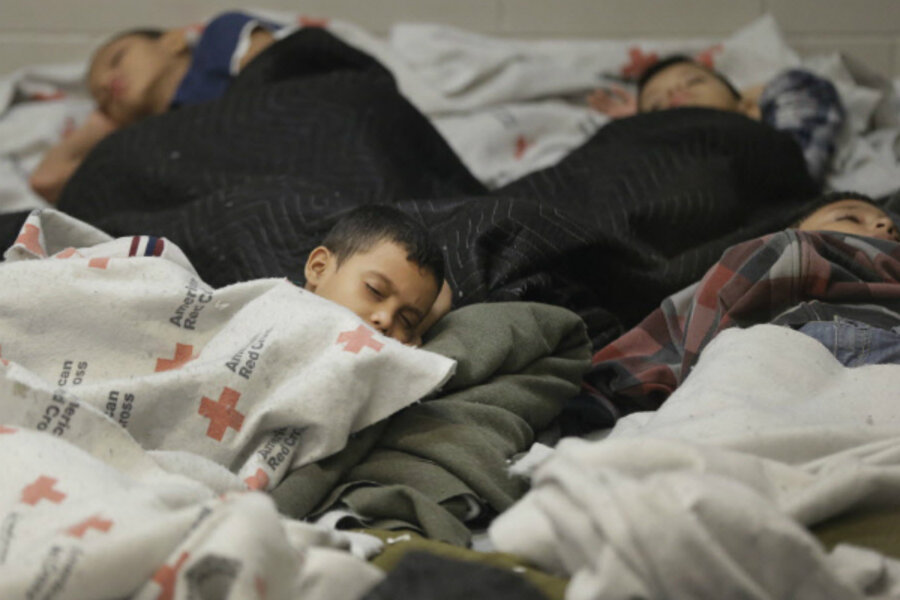Child migrants 101: What does it take to win US asylum?
Loading...
When it comes to the ongoing flood of unaccompanied children illegally crossing the US-Mexico border, the political battle lines have been drawn. Republicans by and large want new spending to focus on the swift deportation of unaccompanied alien children (or UACs, the legal term used in legislation), while Democrats aim to ensure that those eligible for asylum receive it.
The Obama administration says most of these migrant children likely will not be eligible to stay. “Based on what we know about these cases, it is unlikely that most of these kids will qualify for humanitarian relief,” said White House Press Secretary Josh Earnest in a press briefing on July 7.
But what exactly makes a child eligible for asylum? And under what circumstances is a judge likely to grant it?
According to immigration judges and lawyers, the laws are complex, open to interpretation, often misunderstood, and affected by several extralegal factors, including financial and legal resources available to a given applicant.
Here are the two main legal options for unaccompanied children to avoid deportation and stay in the US.
Special Immigrant Juveniles Status
The most common way such minors are granted permanent residency is not via asylum at all, but rather by receiving Special Immigrant Juveniles Status (SIJS), which aims to help foreign children in the United States who have been abused, abandoned, or neglected.
Of all migrant children apprehended traveling alone, 2,588 children, or 42 percent, were potentially eligible for relief in 2011, according to the Department of Health and Human Services. Of those, 1,449 applied for SIJ status, while 785 applied for asylum. (These numbers predate the current big wave of migrant children entering alone. New Border Patrol estimates project that some 90,000 unaccompanied children will try to cross this year.)
Before a US immigration court can take up an SIJS case, a state court must find that the minor is the court’s “dependent,” typically meaning the child has no parent or guardian in the US and cannot be reunited with a parent because of abuse, neglect, abandonment, or a similar reason under state law. The state court must also determine that returning the child to the home country would be against his or her best interests.
This process is complicated, however, because the laws relevant to an SIJS determination vary from state to state, meaning the same child may be eligible for SIJS in Arizona, but not in Texas or California.
What’s more, most unaccompanied minors have no legal representation. Immigration court judges will advise children to pursue a certain legal path, such as receiving an SIJS determination from a state court. But, immigration advocates say, children often lack the resources and the basic understanding of American law to follow the judges' orders.
“Many of these children don’t even know what a lawyer or a deportation order is,” says Kristen Jackson, a lecturer at the University of California at Los Angeles, who specializes in immigration law. “Once … [unaccompanied children] are taken in, all are placed before an immigration judge. The question is whether they’re going to be able to access a state court, which often depends on circumstances beyond their control.”
Not all see the lack of legal resources as a significant issue, however. Some experts point to the existing process to guide SIJS applicants as proof that migrant children are getting a fair shake.
“I can’t imagine that an eligible child is going to slip through the cracks, because the immigration judge is going to go out of his or her way to look out for the interests of the minor,” says Dan Cadman, a fellow at the Center for Immigration Studies, which opposes illegal immigration.
Standard Asylum
The second most popular program for unaccompanied children seeking permanent residency is standard, non-age-specific asylum, which aims to protect people who face torture or persecution back home.
Asylum is typically more difficult to obtain than SIJ status, and as a result, children both with and without legal representation apply for it less often. In 2013, 718 children applied for the program, according to the nonpartisan Migration Policy Institute (MPI).
To be eligible for asylum, an applicant must show that he or she has been persecuted as a result of race, religion, nationality, political opinion, or social group.
“It’s hard to show that your persecution is related to group violence,” says Marc Rosenblum, deputy director of the US immigration program at the MPI. “Gang violence is not a sure win, and judges are discouraged from recognizing generalized violence” as a reason for granting asylum.
The gang-related violence that befalls children in Central America rarely falls under one of the five categories that makes a person eligible for asylum, experts say. Children need to show they face persecution due to a specific group affiliation, so living in an extremely violent neighborhood or region is often not enough.
Unlike SIJS, asylum determinations do not depend on the state where the court is located. However, they do depend on the inclinations of judges to some extent, as the provisions of the asylum law are fluid and interpretable.
According to Judge Dana Marks, president of the National Association of Immigration Judges, the persecution by “social group” criterion for asylum seekers is especially difficult to prove.
“It’s something that’s subject to evolving court interpretation,” she said. “So even experienced judges struggle to determine whether someone is eligible under that category.”
As with SIJ status, minors applying for asylum without lawyers face an especially steep uphill battle, advocates for such children say.
“There are situations that occur when minors don’t have enough connections, and as a result they might miss out on possible relief,” she says.
“[Receiving asylum] depends on whether they have appropriately expressed enough information in the court,” she adds. “This is always hard for a child in a courtroom setting," especially after a child has been through traumatic experiences.





